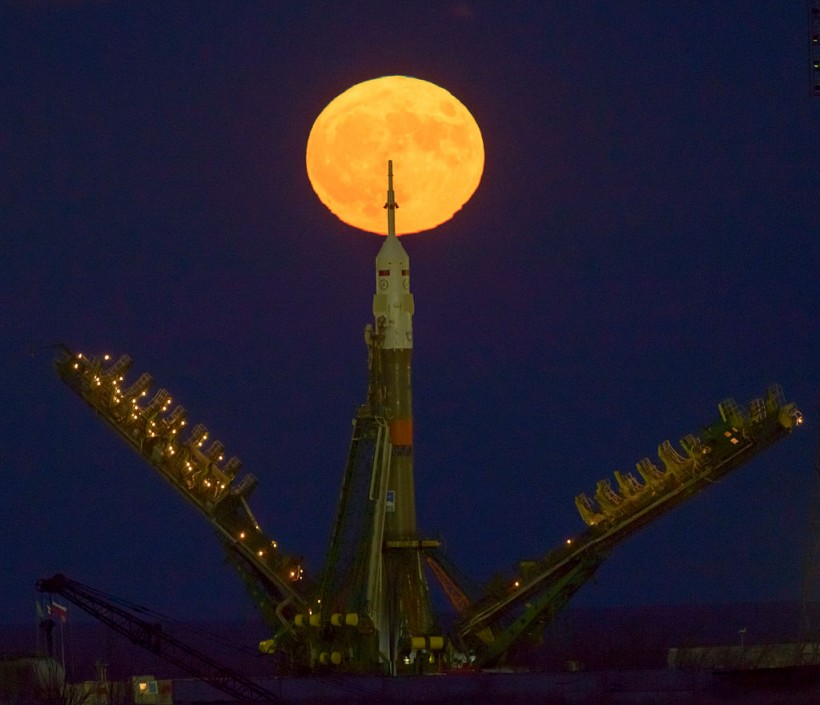Roscosmos, Russia's space agency, recently shared the first images taken by their Luna-25 mission. The images feature Earth as a minute speck in the background while another photo shows the Moon similarly diminutive within the expanse of space. The Luna-25 spacecraft is the country's first lunar mission since 1976.

In this handout provided by NASA, The supermoon, is seen rising behind the Soyuz rocket at the Baikonur Cosmodrome launch pad on November 14, 2016 in Baikonur, Kazakhstan.
Luna-25's First Snaps
As per data officially released, the spacecraft was situated approximately 192,625 miles away from Earth, which roughly equates to 80 percent of the distance to the Moon.
The 1,700-pound probe successfully entered the Moon's orbit on August 16, marking the first Russian mission to achieve this feat in nearly half a century. The objective is to make a Moon landing attempt within the next four to six days.
It was launched on August 10, using a Soyuz rocket from an eastern Russian cosmodrome. As Science Times previously reported, the mission encountered delays due to Russia's involvement in the conflict with Ukraine.
Luna-25 Transmitted First Images From Space — Space Research Institute of the Russian Academy of Sciences
— RT (@RT_com) August 14, 2023
In image two of three, the Earth is visible. Three of three shows the Moon. pic.twitter.com/LrXJ9jhC1V
The photos were taken from a distance of approximately 192,625 miles (310,000 kilometers) away from Earth. The Space Research Institute of the Russian Academy of Sciences indicated that the first of the trio of images affirms the lunar-bound craft's excellent condition and adherence to its intended functioning.
The institute highlighted that all instruments demonstrated complete functionality and preparedness for the upcoming lunar expedition. As Roscosmos said in a statement, the photos illustrate the spacecraft's design elements against the Earth and Moon backgrounds. The space agency also noted the significance of these images, depicting departure from Earth and imminent arrival on the Moon.
READ ALSO: Vladimir Putin Says Russia Will Launch Moon Landings on Its Own; Here's How!
Space Race: Luna-25 Adds to the Growing List of Moon Missions
Russia's Luna-25 is scheduled to make its touchdown on the Moon's surface around August 21 if all goes as planned. While the Soviet Union made historical lunar landings starting with Luna-2 in 1959, a successful mission in 2023 remains uncertain due to Russia's nearly fifty-year hiatus from lunar missions and the challenges posed by limited fuel, absence of GPS navigation, and the lack of atmospheric drag.
The Luna-25 mission is projected to span a year, focusing on researching lunar radiation, natural resources, and conditions in the enigmatic south pole craters for future lunar exploration.
Upon successful landing on the moon, Luna-25 will examine lunar soil, seek water ice, and conduct experiments on the thin lunar atmosphere using its array of eight instruments, which include a laser mass spectrometer and a sample-zapping device for chemical analysis.
Luna-25 now contributes to the expanding roster of international lunar missions with a focus on the southern pole region of the moon. Among these missions, India's Chandrayaan-3 rover recently entered lunar orbit and plans to land near the Moon's south pole by August 23.
Additionally, South Korea launched the Korea Pathfinder Lunar Orbiter (KPLO) in 2022, carrying NASA's ShadowCam instrument designed for identifying water ice near the moon's south pole. Furthermore, NASA's Artemis Program targets a human presence near the moon's south pole as part of the Artemis 3 mission, projected no earlier than 2025.
RELATED ARTICLE: Russia Resumes Lunar Ambitions with Launch of Luna-25 Mission, Entering Moon Race Alongside India
Check out more news and information on Moon Mission in Science Times.



![Earth's Quasi-Moon Kamo‘oalewa Could Originate From Lunar Surface Not Asteroid Belt [Study]](https://1721181113.rsc.cdn77.org/data/thumbs/full/53275/89/56/50/40/earths-quasi-moon-kamo-oalewa-could-originate-from-lunar-surface-not-asteroid-belt-study.png)










